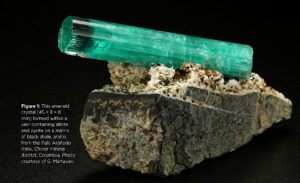Pignatelli, I. ; Giuliani, G. ; Morlot, C. ; Salsi, L. ; Martayan, G.
The journal of Gemmology, 2022, 38, 1, 26-43

`Voir en ligne : https://doi.org/10.15506/JoG.2022.38.1.26
Abstract :
Exceptional mineralogical oddities of gemmological interest have been found in Colombia’s emerald deposits. Their particular sedimentary-hydrothermal geological environment is characterised by large fluid circulations and changes in thermodynamic conditions during emerald precipitation. In this context, various etching processes and growth perturbations affected the crystals in both the eastern and western belts of these emerald deposits. In the eastern belt, variations in post-growth etching are responsible for the formation of ‘vaso’ (cup), ‘spongy’ and spear-shaped emeralds, and etching associated with near-parallel growth of elongated crystals resulted in fibrous emerald specimens. In addition, rare sceptre emeralds formed by epitaxial lateral overgrowth due to the arrival of a later mineralising pulse in the hydrothermal system. ‘Emerald gastropods’ are also found in the eastern belt, and formed by the replacement of fossil aragonite by calcite which later dissolved away and was replaced by emerald. In the western emerald belt, hydrothermal fluid circulation sometimes resulted in non-uniform crystal growth, giving rise to horseshoe-shaped emeralds characterised by an incomplete hexagonal prismatic habit. An unusual sample of a calcitised trapiche emerald—due to fluid circulation affecting trapiche emerald-bearing black shale—is also described.



